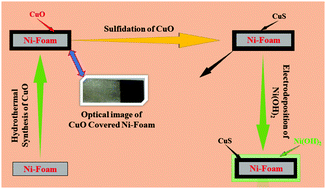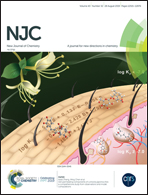Electrodeposited Ni(OH)2-modified CuS core–shell-like hybrids as binder-free electrodes for high-performance supercapacitors†
Abstract
In this work, binder-free electrodes of CuS@Ni(OH)2 were fabricated by hydrothermal and electrodeposition methods. X-ray diffraction (XRD) and transmission electron microscopy (TEM) results confirmed the crystallinity of the electrodes. Nanosheet-like morphology and surface modification of CuS were confirmed by scanning electron microscopy (SEM) images. The actual composition of the core–shell-like hybrids was identified by X-ray photoelectron spectroscopy (XPS) analysis. The thickness of the electrodes was measured by atomic force microscopy (AFM) imaging. Cyclic voltammetry results revealed the redox nature and improved electrochemical activity with shifted redox peaks. The ionic conductivity of the core–shell hybrids was much higher than that of the pristine CuS. CuS@Ni(OH)2 – 5 minutes delivered an ultra-high specific capacitance of 3585 F g−1 at a current density of 1 A g−1. The retained capacitance of CuS@Ni(OH)2 – 7 minutes was 465 F g−1 (59%) in the 4000th cycle. The above results endorse that the core–shell-like hybrids of CuS@Ni(OH)2 satisfy the demands of supercapacitor applications.


 Please wait while we load your content...
Please wait while we load your content...